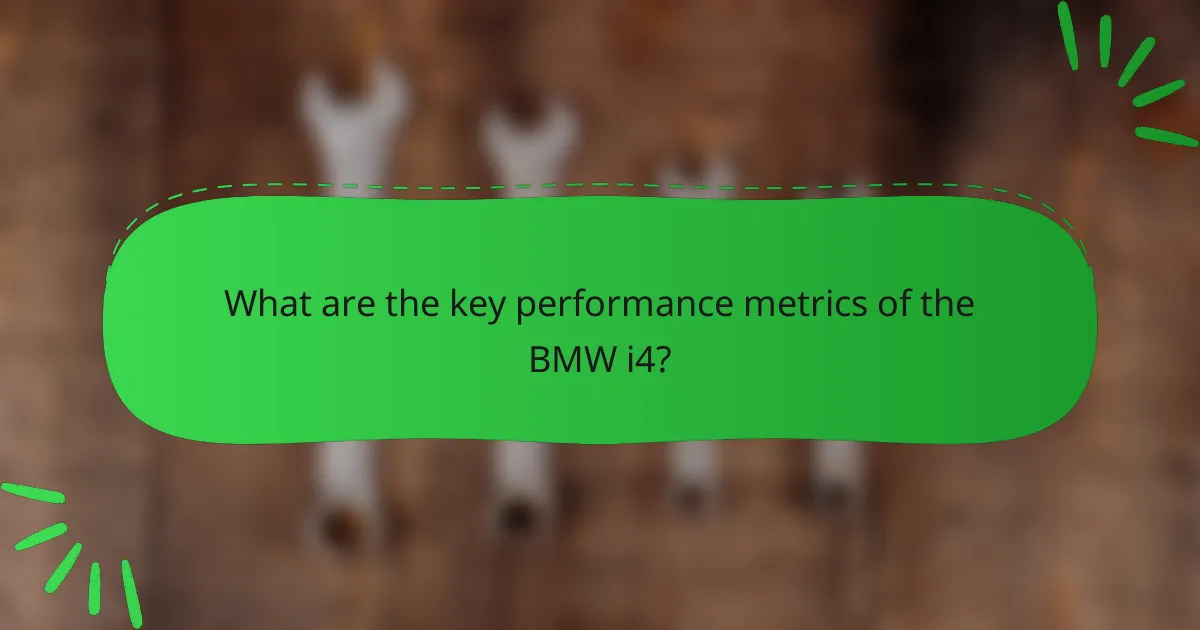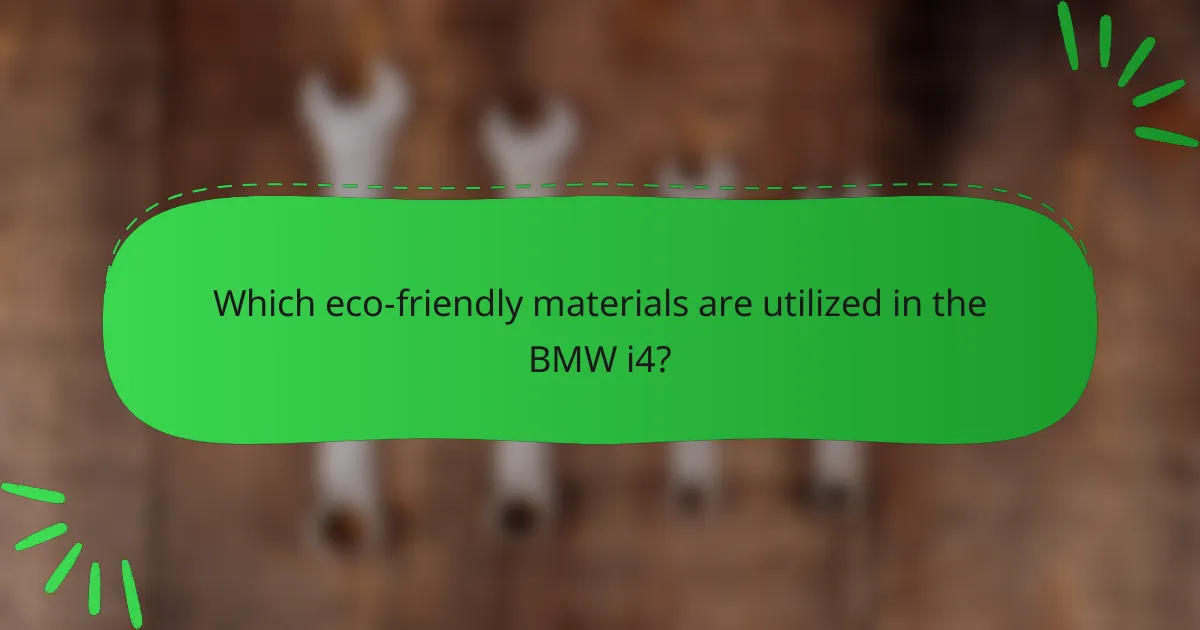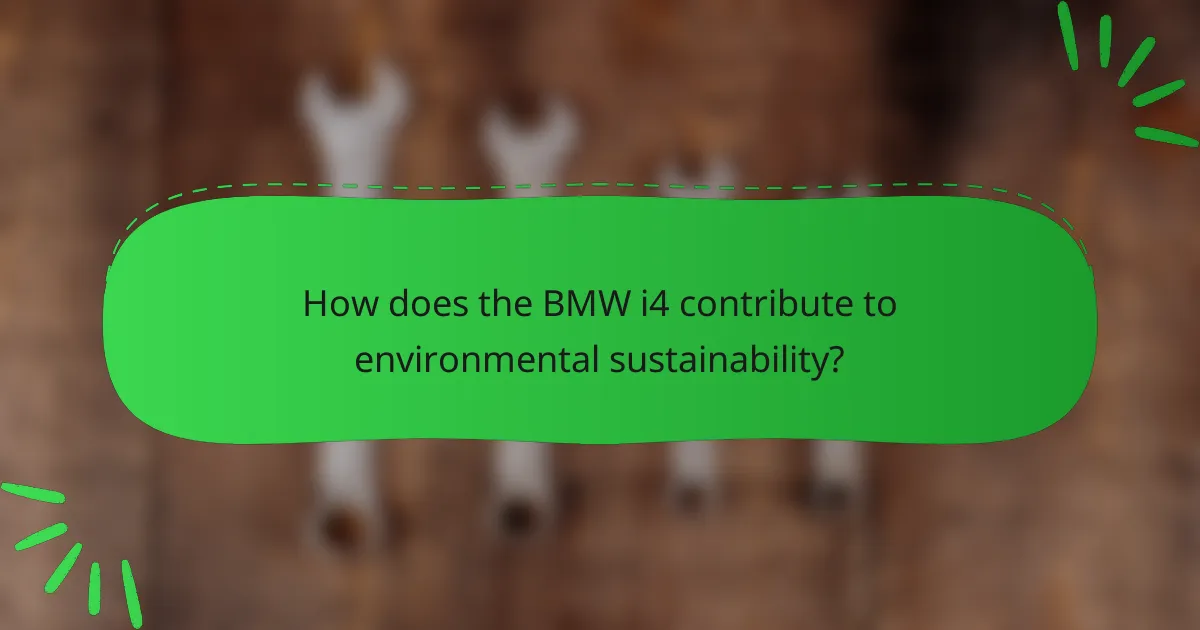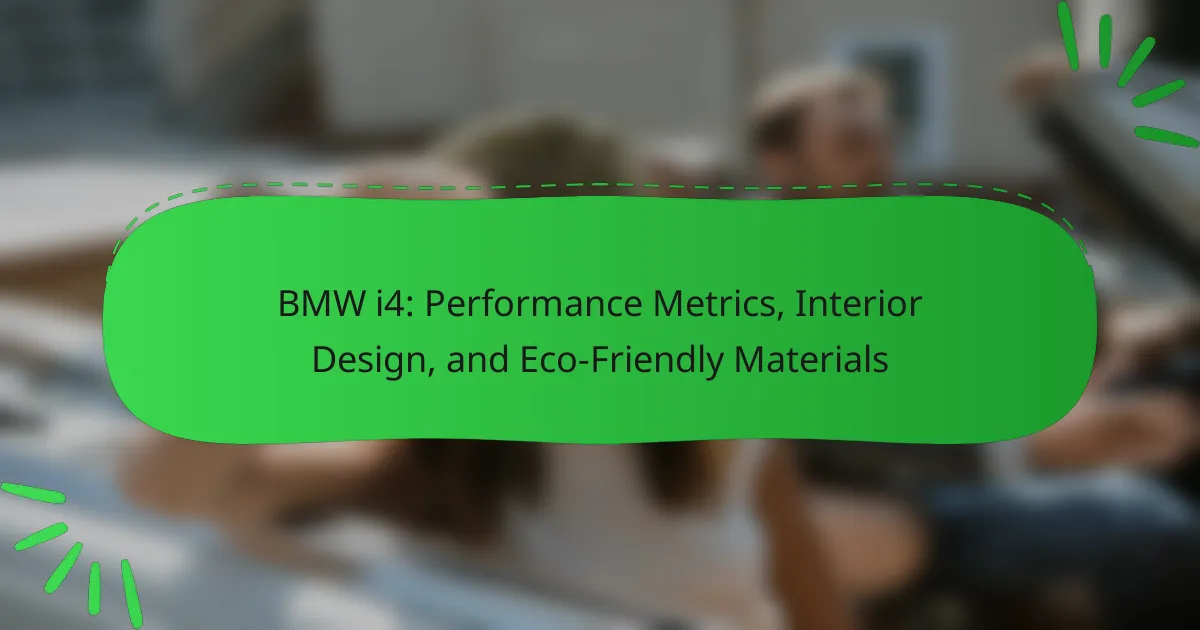The BMW i4 offers a compelling blend of performance, luxury, and sustainability. It boasts impressive metrics like a 0-60 mph time of 3.7 seconds and a range of up to 300 miles. The interior features advanced technology and eco-friendly materials, enhancing both comfort and environmental responsibility. This article explores the i4’s performance metrics, interior design, and commitment to sustainable materials.

What are the key performance metrics of the BMW i4?
The key performance metrics of the BMW i4 include impressive acceleration, range, and power output. The i4 can achieve 0 to 60 mph in approximately 3.7 seconds. It offers an electric range of up to 300 miles on a single charge. The power output reaches up to 536 horsepower, showcasing its robust performance capabilities. Additionally, it features advanced handling with a low centre of gravity, enhancing driving dynamics.
How does acceleration compare to traditional BMW models?
The BMW i4 accelerates faster than many traditional BMW models, showcasing a unique electric performance. The i4 achieves 0-60 mph in approximately 3.7 seconds, surpassing the acceleration of petrol-powered counterparts like the BMW M3. The instant torque from the electric motor provides a distinct driving experience, setting it apart in the performance metrics category. Additionally, the i4’s eco-friendly materials contribute to its innovative design, aligning performance with sustainability.
What is the range on a full charge?
The BMW i4 offers a range of approximately 300 miles on a full charge. This electric vehicle combines performance with efficiency, making it suitable for both daily use and longer trips. The range may vary based on driving conditions and usage patterns.
How does the BMW i4 handle in various driving conditions?
The BMW i4 handles exceptionally well in various driving conditions due to its advanced engineering and electric powertrain. Its low centre of gravity enhances stability, making it agile on winding roads. In wet or slippery conditions, the all-wheel-drive system provides optimal traction, ensuring confident handling. The vehicle’s regenerative braking system also contributes to enhanced control, allowing for smooth deceleration. Overall, the BMW i4’s performance metrics reflect its adaptability across diverse environments, offering a balanced and responsive driving experience.
What are the charging options and times available?
The BMW i4 offers multiple charging options with varying times. It supports AC charging with a maximum power of 11 kW, allowing a full charge in approximately 8.5 hours. For DC fast charging, it can accept up to 205 kW, enabling an 80% charge in around 30 minutes. This flexibility ensures convenient charging for various user needs.
How do the performance metrics impact driving experience?
Performance metrics significantly enhance the driving experience of the BMW i4 by optimizing performance, comfort, and efficiency. Metrics like acceleration, handling, and range directly influence how the vehicle responds to driver inputs. The i4’s impressive 0-60 mph time of around 3.8 seconds showcases its rapid acceleration, making every drive exhilarating.
Additionally, the vehicle’s handling, aided by precise steering and a low centre of gravity, contributes to a responsive and engaging experience on various terrains. The advanced regenerative braking system not only improves efficiency but also enhances control during deceleration, further enriching the driving experience.
Moreover, performance metrics such as range—approximately 300 miles on a single charge—allow for longer journeys without frequent stops, making it practical for daily use and road trips. The integration of these metrics ensures that the BMW i4 delivers a harmonious blend of performance and sustainability.

What interior design features set the BMW i4 apart?
The BMW i4 stands out with its luxurious interior design, featuring sustainable materials and advanced technology. The minimalist dashboard integrates a curved display, enhancing user experience. Ambient lighting and high-quality upholstery create a refined atmosphere. Unique attributes include eco-friendly materials like recycled plastics and natural fibres, emphasizing sustainability. The spacious cabin offers comfort and practicality, making it ideal for both drivers and passengers.
How does the layout enhance driver and passenger comfort?
The layout of the BMW i4 optimizes driver and passenger comfort through thoughtful design and ergonomic features. Spacious seating enhances legroom, while premium materials create a luxurious ambiance. The intuitive dashboard layout ensures easy access to controls, reducing distractions. Additionally, advanced climate control systems maintain a comfortable environment, contributing to an enjoyable ride.
What technology integrations are included in the interior design?
The BMW i4 integrates advanced technology for a modern interior experience. Key features include a high-resolution digital display, a premium sound system, and smart connectivity options. The vehicle supports wireless smartphone integration and offers customizable ambient lighting. Additionally, advanced driver-assistance systems enhance safety and convenience.
How do materials used in the interior reflect sustainability?
The materials used in the BMW i4’s interior reflect sustainability through their eco-friendly properties and sourcing practices. The vehicle incorporates recycled plastics, sustainably sourced wood, and vegan leather, reducing environmental impact. These materials enhance the car’s aesthetic while promoting a commitment to sustainability. For example, the use of recycled materials minimizes waste and lowers carbon footprint. The i4’s interior design exemplifies how luxury and eco-consciousness can coexist effectively.

Which eco-friendly materials are utilized in the BMW i4?
The BMW i4 utilizes various eco-friendly materials, including recycled plastics, sustainably sourced wood, and natural fibres. These materials enhance sustainability while maintaining luxury and performance. For example, the interior features upholstery made from recycled PET bottles, reducing waste and environmental impact. Additionally, the use of natural fibres in certain trims promotes renewable resources, aligning with BMW’s commitment to sustainability.
What are the benefits of using recycled materials in the i4?
Using recycled materials in the BMW i4 enhances sustainability, reduces environmental impact, and promotes resource efficiency. These materials contribute to a lighter vehicle, improving performance and energy efficiency. Additionally, they support BMW’s commitment to eco-friendly practices and innovation. The integration of recycled components showcases the brand’s dedication to reducing waste and promoting circular economy principles.
How does the choice of materials affect the vehicle’s weight and performance?
The choice of materials significantly impacts the BMW i4’s weight and performance. Lightweight materials, such as aluminium and carbon fibre, enhance agility and efficiency. For instance, the i4’s use of these materials reduces overall mass, improving acceleration and handling. Additionally, eco-friendly materials contribute to sustainability without compromising performance metrics. This strategic selection balances performance and environmental responsibility, showcasing BMW’s commitment to innovation.
What innovations in sustainable materials are showcased in the BMW i4?
The BMW i4 showcases several innovations in sustainable materials, emphasizing eco-friendliness without compromising luxury. It features recycled plastics, natural fibres, and leather alternatives, contributing to a reduced environmental footprint. The vehicle’s interior design integrates these materials seamlessly, enhancing both aesthetics and sustainability. Notably, the use of innovative materials like vegan leather not only supports animal welfare but also aligns with modern consumer preferences for sustainable options.

How does the BMW i4 contribute to environmental sustainability?
The BMW i4 contributes to environmental sustainability through its electric powertrain and eco-friendly materials. It produces zero tailpipe emissions, significantly reducing air pollution. The vehicle utilizes recycled materials in its interior, decreasing resource consumption. Additionally, the i4’s energy efficiency is enhanced by regenerative braking, which captures energy during deceleration. This sustainable approach aligns with BMW’s commitment to reducing its carbon footprint and promoting greener transportation options.
What initiatives does BMW have in place for reducing carbon footprint?
BMW has implemented several initiatives to reduce its carbon footprint, focusing on electric vehicle production and sustainable materials. The BMW i4, as part of this strategy, features a fully electric powertrain that produces zero tailpipe emissions. The vehicle’s interior utilizes eco-friendly materials, such as recycled plastics and sustainably sourced textiles, which contribute to a lower environmental impact. Additionally, BMW aims for carbon neutrality across its production processes by 2025, enhancing energy efficiency and utilizing renewable energy sources.
How does the i4’s manufacturing process support eco-friendly practices?
The BMW i4’s manufacturing process incorporates eco-friendly practices through sustainable materials and energy-efficient production methods. This electric vehicle utilizes recycled materials in its interior design, minimizing waste. The manufacturing plants are powered by renewable energy, significantly reducing carbon emissions. Additionally, the i4’s production emphasizes resource efficiency, ensuring minimal environmental impact throughout its lifecycle.
What certifications or recognitions has the BMW i4 received for sustainability?
The BMW i4 has received several certifications for sustainability, including the “Green Vehicle” certification from the Green Car Journal. It also boasts a five-star rating from Euro NCAP for safety and environmental performance. Additionally, the i4 is recognized for its use of eco-friendly materials in its interior design, contributing to its overall sustainability profile.
What are the common misconceptions about electric vehicles like the BMW i4?
Many misconceptions about the BMW i4 stem from misunderstandings of electric vehicles. Common myths include beliefs that electric vehicles lack performance, have limited range, and are not environmentally friendly.
In reality, the BMW i4 offers impressive performance metrics, including rapid acceleration and high top speeds, comparable to traditional sports cars. Its range is competitive, often exceeding 300 miles on a single charge, alleviating concerns about battery life. Additionally, the use of eco-friendly materials in the i4’s interior design emphasizes sustainability, contradicting notions that electric vehicles compromise on luxury or style.
These attributes highlight the BMW i4 as a viable and appealing option in the electric vehicle market, challenging prevalent misconceptions.

How can potential buyers optimize their BMW i4 experience?
To optimize their BMW i4 experience, potential buyers should focus on performance metrics, interior design, and eco-friendly materials.
First, understand the performance metrics, including the 0-60 mph time of approximately 3.7 seconds and a range of up to 300 miles. This ensures the vehicle meets both speed and efficiency needs.
Next, explore the interior design, which features high-quality materials and advanced technology, enhancing comfort and driving experience. The minimalist layout promotes an intuitive interface for drivers.
Lastly, appreciate the eco-friendly materials used in the BMW i4, such as recycled plastics and sustainably sourced textiles. This commitment to sustainability aligns with modern consumer values.
What are the best practices for maintaining the BMW i4?
Regular maintenance of the BMW i4 ensures optimal performance and longevity. Key practices include timely software updates, regular tyre rotations, and battery health checks.
1. Schedule routine inspections every 10,000 miles or annually.
2. Monitor tyre pressure monthly; maintain recommended levels for efficiency.
3. Use genuine BMW parts for replacements to ensure compatibility and performance.
4. Keep the battery charged between 20% and 80% to enhance lifespan.
5. Clean the exterior and interior regularly to preserve aesthetics and materials.
These practices help maintain the i4’s performance metrics and eco-friendly materials effectively.
How can drivers maximize the i4’s range and performance?
To maximize the BMW i4’s range and performance, drivers should adopt efficient driving habits and utilize vehicle features effectively.
Maintaining a steady speed and minimizing rapid acceleration can significantly enhance energy efficiency. Utilizing the regenerative braking feature helps recover energy during deceleration, extending range.
Additionally, keeping the tyre pressure at optimal levels reduces rolling resistance, further improving performance. Drivers should also consider using eco-driving modes, which adjust power delivery for better efficiency.
Lastly, planning routes to avoid heavy traffic and using climate control judiciously can lead to a more efficient driving experience.
What are the most common mistakes to avoid with electric vehicles?
Common mistakes to avoid with electric vehicles include neglecting charging infrastructure, overlooking range limitations, and misunderstanding maintenance needs. Many users fail to plan for charging stations, which can lead to inconvenience. Additionally, not accounting for real-world driving range can result in unexpected shortfalls. Lastly, some may assume electric vehicles require no maintenance, but regular checks are essential for optimal performance.
